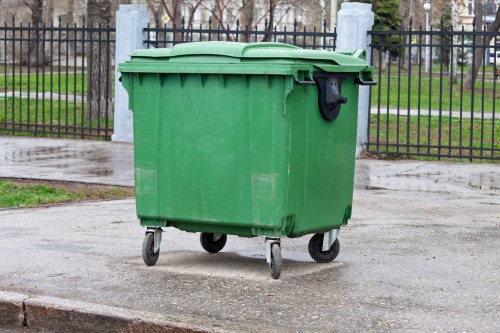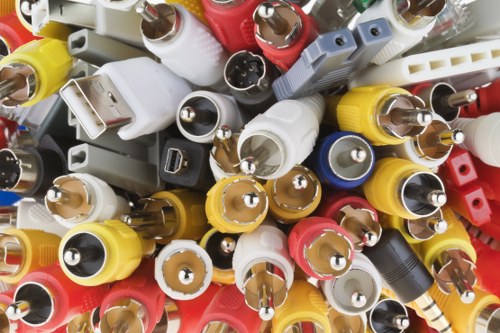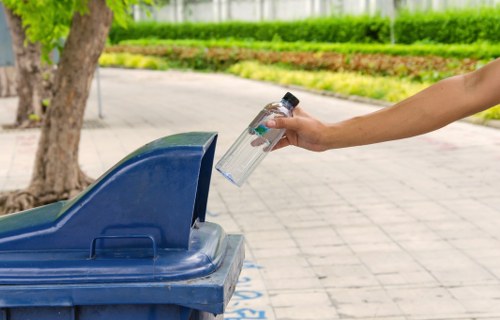Comprehensive Guide to Garden Clearance in Sands End

Maintaining a beautiful garden in Sands End requires regular upkeep, and sometimes that means undertaking a garden clearance. Whether you're preparing to sell your home, renovating, or simply looking to refresh your outdoor space, garden clearance is an essential task.
Garden clearance involves removing unwanted plants, debris, old furniture, and any other items that no longer serve your garden's aesthetic or functional purposes. This process can be overwhelming, especially if done alone, but with the right approach and professional help, it can be manageable and even enjoyable.
In this guide, we will explore the ins and outs of garden clearance in Sands End, providing you with valuable insights and practical tips to achieve a clutter-free and vibrant garden.

Why Garden Clearance is Important
Garden clearance is more than just tidying up. It plays a crucial role in maintaining the health and beauty of your garden. Here are some key reasons why garden clearance is important:
- Healthier Plants: Removing dead or diseased plants prevents the spread of pests and diseases to healthy plants.
- Aesthetics: A clear and organized garden looks more appealing, enhancing your home's overall appearance.
- Safety: Clearing debris and old structures reduces the risk of accidents and injuries.
- Space Optimization: Removing unnecessary items creates more space for new plants and garden features.
- Environmental Benefits: Proper clearance can improve soil health and promote sustainable gardening practices.

Steps to Effective Garden Clearance
1. Planning and Assessment
Before starting the clearance process, assess your garden's current state. Identify areas that need attention and decide what you want to achieve. Planning helps ensure a smooth and efficient clearance process.
2. Sorting and Organizing
Sort through all items in your garden. Categorize them into items to keep, donate, recycle, or dispose of. This step helps reduce clutter and makes the clearance process more manageable.
3. Removal of Unwanted Items
Carefully remove unwanted plants, debris, old furniture, and other items. Ensure you follow local disposal regulations, especially for plant material and bulky items.
Tips for Safe Removal:
- Wear protective clothing and gloves.
- Use appropriate tools for dismantling furniture or removing plants.
- Consider hiring professionals for large or hazardous tasks.

Hiring Professional Garden Clearance Services in Sands End
While DIY garden clearance is possible, hiring professional services can save you time and effort. Professionals have the expertise and equipment to handle large-scale clearances efficiently and safely.
Benefits of Professional Services:
- Expertise: Knowledgeable about local plants and disposal regulations.
- Efficiency: Equipped with the right tools and machinery.
- Safety: Adhere to safety standards, reducing the risk of accidents.
- Time-Saving: Complete the clearance quickly, allowing you to focus on other tasks.
Choosing the Right Service:
- Research local providers and read reviews.
- Compare quotes and services offered.
- Ensure they are licensed and insured.
- Ask for references or examples of previous work.

Eco-Friendly Garden Clearance Practices
Embracing eco-friendly practices during garden clearance helps protect the environment and promotes sustainability. Here are some ways to make your garden clearance greener:
Recycling and Reusing
Instead of sending everything to landfill, recycle materials like metal, wood, and plastic. Reuse old furniture by refurbishing or donating it to charity.
Composting
Compost organic waste such as leaves, branches, and plant trimmings. Composting enriches the soil and reduces the amount of waste going to landfill.
Proper Disposal
Dispose of non-recyclable and hazardous materials responsibly. Follow local guidelines for waste disposal to minimize environmental impact.
Benefits of Eco-Friendly Practices:
- Reduces environmental footprint.
- Enhances soil health.
- Supports sustainable gardening.
- Promotes community well-being.
Cost of Garden Clearance in Sands End
The cost of garden clearance can vary based on several factors, including the size of your garden, the amount of debris, and the specific services required. On average, homeowners in Sands End can expect to pay between £200 and £800 for a comprehensive garden clearance.
Factors Influencing Cost:
- Garden Size: Larger gardens require more time and resources.
- Amount of Debris: More debris means higher disposal and labor costs.
- Service Scope: Additional services like disposal, recycling, and composting can affect the price.
Saving on Costs:
- Get multiple quotes from different providers.
- Plan and prioritize tasks to reduce the scope of work.
- Consider doing some tasks yourself to lower labor costs.
Maintaining Your Garden After Clearance
Once you have successfully cleared your garden, maintaining it is crucial to prevent clutter from building up again. Regular maintenance ensures your garden remains tidy and beautiful throughout the year.
Scheduled Maintenance Tasks:
- Regularly remove weeds and dead plants.
- Prune and trim shrubs and trees.
- Clean garden furniture and structures.
- Monitor for pests and diseases.
- Maintain compost and recycling areas.
Creating a Maintenance Plan:
Develop a seasonal maintenance plan to address specific tasks throughout the year. This proactive approach helps keep your garden in top condition and reduces the need for extensive clearance.
Tips for Effective Maintenance:
- Set aside regular time for garden upkeep.
- Use the right tools and equipment.
- Stay informed about best gardening practices.
- Consider professional help for complex tasks.
Local Relevance: Garden Clearance in Nearby Areas to Sands End
Sands End is surrounded by several charming areas that also require garden clearance services. Understanding the proximity and unique features of these nearby locations can help you choose the best service provider for your needs.
Closest Areas to Sands End:
- Earls Court: Just a short distance away, Earls Court offers residential areas with diverse garden styles requiring personalized clearance solutions.
- Kensington Gardens: Known for its expansive gardens, clearance services here focus on maintaining large and historic outdoor spaces.
- Fulham: Fulham’s mix of old and new homes means gardens vary significantly, necessitating tailored clearance approaches.
- Hammersmith: With its bustling community, Hammersmith gardens often need efficient and quick clearance services.
- Chelsea: Chelsea’s high-end residences require meticulous and careful garden clearance to preserve property value.
- West Brompton: This area’s proximity to Sands End makes it a popular choice for residents seeking convenient garden clearance services.
- South Kensington: South Kensington gardens are typically smaller but demand thorough and precise clearance work.
- Notting Hill: Known for its vibrant gardens, garden clearance in Notting Hill often involves managing colorful and diverse plant species.
- Barons Court: Barons Court offers a variety of garden spaces, each with unique clearance needs based on architectural styles.
- White City: White City’s modern homes often include minimalistic gardens that require simple yet effective clearance methods.
- Chiswick: With its leafy streets and spacious gardens, Chiswick clearance focuses on maintaining lush and well-kept outdoor areas.
- Shepherd's Bush: Shepherd's Bush has urban garden spaces that need innovative clearance solutions to maximize limited areas.
- South Kensington: Smaller, yet intricate gardens necessitate detailed and careful clearance efforts.
Common Challenges in Garden Clearance
Garden clearance can come with its own set of challenges. Being aware of these can help you prepare and address them effectively:
Heavy Debris
Removing large branches, old furniture, and other heavy items can be physically demanding. Hiring professionals can ease this burden.
Access Constraints
Narrow pathways and limited access to your garden can make clearance difficult. Proper planning and tool selection are essential.
Unwanted Vegetation
Overgrown plants and invasive species require careful removal to prevent damage to remaining healthy plants.
Solutions to Common Challenges:
- Use appropriate tools and equipment.
- Plan the clearance in stages if necessary.
- Seek professional assistance for complex tasks.
- Implement preventive measures post-clearance.
Benefits of Regular Garden Clearance
Maintaining regular garden clearance offers numerous benefits that extend beyond aesthetics:
Enhanced Property Value
A well-maintained garden can significantly increase your property’s market value, making it a wise investment.
Improved Safety
Regular clearance minimizes hazards such as falling branches and tripping over debris, ensuring a safe environment.
Better Plant Health
Removing dead and diseased plants fosters a healthier garden ecosystem, promoting robust plant growth.
Increased Curb Appeal
An orderly garden enhances the overall curb appeal of your home, creating a positive first impression.
Long-Term Advantages:
- Preservation of garden structures and plants.
- Efficient use of garden space.
- Facilitation of easier gardening tasks.
- Promotion of sustainable gardening practices.
Choosing the Right Time for Garden Clearance
Timing is crucial when planning garden clearance. Selecting the appropriate season can make the process more efficient and less disruptive.
Best Times of the Year:
- Spring: Ideal for clearing out winter debris and preparing for the growing season.
- Autumn: Good for removing fallen leaves and preparing plants for winter.
- Early Summer: Suitable for pruning and managing new growth.
Considerations for Timing:
- Weather Conditions: Avoid rainy or extremely cold periods.
- Plant Cycles: Ensure clearance does not disrupt plant growth cycles.
- Personal Schedule: Choose a time that fits your availability and energy levels.
Seasonal Tips:
- Plan clearance tasks around plant blooming and blooming periods.
- Use seasonal produce for composting.
- Protect sensitive plants during clearance.
Tools and Equipment for Garden Clearance
Having the right tools and equipment can make garden clearance more efficient and less strenuous. Here are some essential items you'll need:
Basic Tools:
- Garden Fork: For turning and aerating the soil.
- Pruning Shears: For trimming plants and removing dead branches.
- Garden Gloves: To protect your hands from thorns and debris.
- Wheelbarrow: For transporting soil, compost, and debris.
Advanced Equipment:
- Loppers: For cutting larger branches.
- Chainsaw: For removing thick branches or trees.
- Garden Shredder: To turn debris into mulch.
- Rake: For gathering leaves and light debris.
Safety Gear:
- Protective eyewear
- Long sleeves and sturdy footwear
- Ear protection for loud equipment
Maintenance of Tools:
Properly maintaining your tools ensures their longevity and effectiveness. Clean tools after use, sharpen blades regularly, and store them in a dry place.
Environmental Considerations in Garden Clearance
Environmental sustainability should be a key consideration during garden clearance. Here’s how you can minimize your environmental impact:
Minimizing Waste:
Reduce the amount of waste sent to landfill by recycling and reusing materials wherever possible.
Promoting Biodiversity:
Maintain a variety of plants to support local wildlife and enhance garden biodiversity.
Soil Conservation:
Proper clearance practices help preserve soil health, preventing erosion and nutrient depletion.
Green Practices:
- Use natural fertilizers and compost.
- Implement rainwater harvesting systems.
- Choose native plants that require less maintenance.
Legal Regulations for Garden Clearance in Sands End
Understanding local regulations is essential to ensure your garden clearance complies with the law. Here are some key points to consider:
Disposal Regulations
Certain items, such as treated wood, paint, and other hazardous materials, require special disposal methods. Contact your local council for guidelines.
Building Regulations
If your garden clearance involves structural changes, like removing sheds or fencing, you may need planning permission.
Protected Plants
Some plants are protected by law. Ensure you’re not removing or damaging any protected species during clearance.
Compliance Tips:
- Check with the local council for specific regulations.
- Obtain necessary permits before starting clearance.
- Properly label and separate hazardous materials.
- Hire professionals knowledgeable about local laws.
Conclusion: Achieving a Beautiful Garden in Sands End
Garden clearance is a vital step in maintaining a beautiful and healthy outdoor space in Sands End. By following the outlined steps, hiring professionals when needed, and adopting eco-friendly practices, you can create a garden that is both aesthetically pleasing and environmentally sustainable.
Remember that regular maintenance is key to preventing clutter and ensuring your garden remains a source of joy and relaxation. Whether you're clearing out old plants or making room for new features, a well-maintained garden enhances your home and contributes to the overall well-being of the community.
Frequently Asked Questions
1. How often should I clear my garden in Sands End?
It's recommended to perform a thorough garden clearance at least twice a year, typically in spring and autumn, to maintain a healthy and attractive garden.
2. Can I donate my old garden furniture instead of disposing of it?
Yes, donating old garden furniture is a great way to recycle and help those in need. Many local charities and community groups accept garden items in good condition.
3. Are there any plants I should avoid removing during garden clearance?
Yes, some plants are protected by law or are beneficial to the local ecosystem. Always check with local guidelines before removing any plants.
4. Is garden clearance included in professional landscaping services?
Many professional landscaping services include garden clearance as part of their offerings, but it's best to confirm with the provider to ensure it meets your specific needs.
5. How can I make my garden clearance more environmentally friendly?
You can make your garden clearance more eco-friendly by recycling materials, composting organic waste, and reusing or donating items whenever possible.